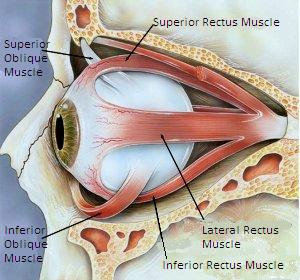Home > about eyes > Computer Vision Syndrome (CVS) > The Relationship of Computer Vision Syndrome to Musculoskeletal Disorders
The Relationship of Computer Vision Syndrome to Musculoskeletal Disorders
Many individuals who work at a computer video display terminal(s) (VDT) suffer from symptoms such as ocular discomfort, muscular strain (neck and back as well as eye), and stress. Surveys of computer workers show that eye and vision problems are the most frequently reported health-related problems, generally occurring in 70 to 75 percent of computer workers. (1-3) The complex of eye and vision problems related to near work experienced during computer use has been termed "computer vision syndrome". (4)
The elements of working at a computer which make it visually demanding include frequent saccadic eye movements (ocular motility) and continuous eye focusing (accommodation) and alignment (vergence) demands. Problems occur when the visual demands of the task exceed the visual abilities of the individual to comfortably perform the task.
|
Eye movements, eye focusing, and eye alignment processes involve repetitious muscular activity. The movement of each of the eyes is controlled by six extra-ocular muscles(5) that are responsible for proper alignment of the eyes when viewing objects such as the computer screen. The ability of the eyes to change focus is controlled by the ciliary muscle, which exerts a force on the internal lens of the eye.(6) In many respects, many computer related vision problems can be considered a form of musculoskeletal disorder, commonly referred to as cumulative trauma disorder (CTD) or repetitive stress injuries (RSI).(7) The relationship between computer related vision problems and RSI include: |
 |
- Symptoms are work related and associated with repetitive activity -- The development of computer vision syndrome is related to the unique aspects of the task. Working at a computer is more visually demanding than doing other standard office work such as reading printed documents. Aspects of the design of the computer video display such as screen resolution and contrast, image refresh rates and flicker, and screen glare, as well as working distances and angles all may contribute to worker symptoms.(8,9)
- Repetitive eye movements: In order to accomplish specific computer related tasks, frequent eye movements from work documents to the computer screen, or from the screen to the keyboard and back again, are used. In addition, as the object being viewed changes, so does the need for a change in eye focusing to maintain a clear image. These changes occur repeatedly during computer work. The flexibility of the lens within the eye gradually decreases with age resulting in a condition called presbyopia, which affects most people after about age 40. As a result, individuals are unable to adequately focus on close work and computer screens without a proper spectacle lens correction.(10)
- Problems are related to disorders of muscles, tendons, bones, or nerves -- Ocular motility, accommodative and vergence disorders are due to problems with the neuromuscular control mechanisms of these functions.
- Problems occur or are aggravated by repeated movements -- The visual symptoms that occur from working at a computer are the result of repeatedly stressing some aspect of the eyes or visual system. Asthenopia and visual symptoms result from the task difficulty and duration stressing the accommodative and eye coordination systems.
Eye-related symptoms and the underlying vision condition may be aggravated and/or precipitated by repeated work at a computer. This is not dissimilar from other types of RSIs in which a part of the human physiology functions properly with normal activity, but breaks down and causes symptoms when strained or stressed.
- A lengthy period of time is required for the problems to develop and for the individual to recover -- Although vision disorders may occur as localized fatigue and subside after discontinuance of work, they often return the next day when work is resumed. Unlike other forms of localized fatigue, the visual system is not able to adapt to the conditions that cause the fatigue so that it no longer occurs with regular exposure. Some vision problems may become more significant over time.(11)
Many aspects of computer vision syndrome meet the same criteria used to define cumulative trauma disorders or repetitive stress injuries. Because of the impact of computer vision syndrome on worker comfort and productivity, we recommend annual eye checkups for all regular users of computers.
Back to CVS... Next (Children & CVS)
REFERENCES
- Smith MJ, Cohen BGF, Stammerjohn LW. An investigation of health complaints and job stress in video display operations. Hum Factors 1981; 23:387-400.
- Collins MS, Brown B, Bowman KJ, Caird D. Task variables and visual discomfort associated with the use of VDTs. Optom Vis Sci 1991; 68:27-33.
- Dain SJ, McCarthy AK, Chan-Ling T. Symptoms in VDU operators. Am J Optom Physiol Opt 1988; 65:162-7.
- American Optometric Association. Guide to the clinical aspects of computer vision syndrome. St. Louis: American Optometric Association, 1995:1.
- Davison H. The extraocular muscles and their actions. In: Physiology of the eye (Fifth edition). New York: Pergamon Press, 1990:647-66.
- Davison H. Accommodation. In: Physiology of the eye (Fifth edition). New York: Pergamon Press, 1990:768-76.
- Sheedy JE. How do eye problems rank with other VDU disorders? In: Grieco A, Molteni G, Occhipinti E, Piccoli B, eds. Work with display units. Fourth International Scientific Conference Book of Short Papers, vol 2. University of Milan, Italy, Oct 2-5, 1994.
- Campbell FW, Durden K. The visual display terminal issue: A consideration of its physiological, psychological and clinical background. Ophthal Physiol Opt 1983; 3:175-92.
- Miller SC. Meeting the eye care needs of video display terminal operators. J Am Optom Assoc 1984; 55:611-8.
- Jaschinski-Kruza, W. Eye strain in VDU users: Viewing distance and the resting position of ocular muscles. Human Factors 1991; 33:69-83.
- Gur S, Ron S. Does work with visual display units impair visual activities after work? Documenta Ophthal 1992; 79:253-9.



